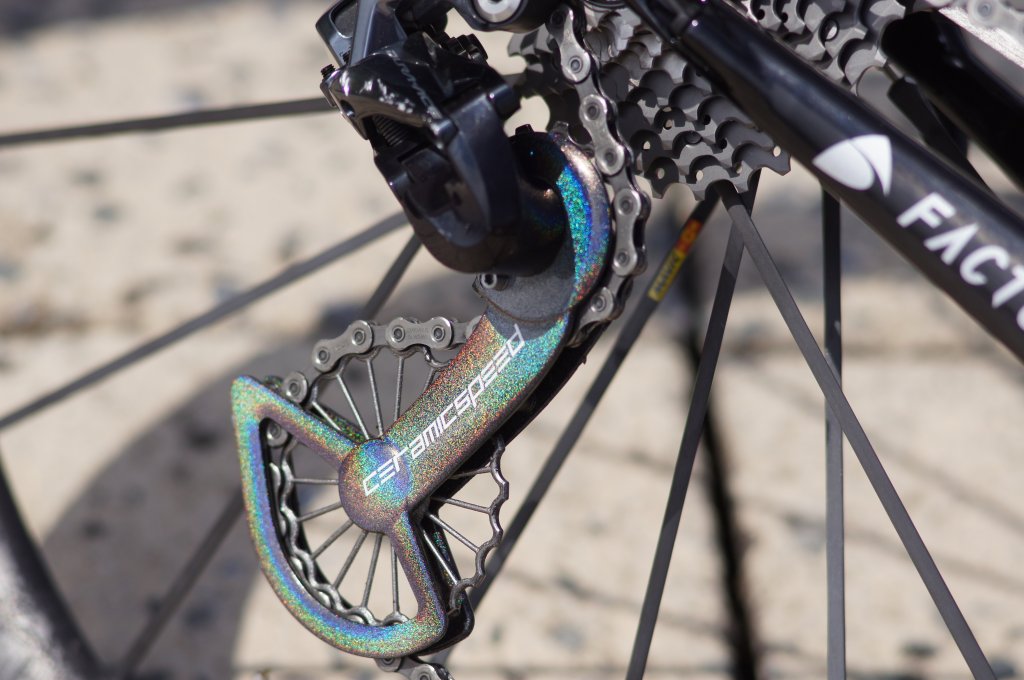Germany’s SLM Solutions was a major catalyst recently in expanding manufacturing for a specific 3D printed bicycle part designed by CeramicSpeed, a Danish cycling company working in cooperation with selective laser melting experts Danish Technological Institute. Partnering to improve performance in cycling, the innovators worked together to create a durable titanium pulley wheel.
Testing this new part in this year’s Tour de France, the group of innovators found that the part was both road- and race-worthy. This is not CeramicSpeed’s first revolutionary part, however, as they continue to make a difference in professional cycling with components like ceramic bearings. In working with DTI, they can produce their parts on either a quad-laser SLM®500 or twin SLM®280 system.
“3D printing technology has given us a lot of leeway to experiment creatively with design, while at the same time being able to optimize a product’s function,” Carsten Ebbesen, R&D Manager at CeramicSpeed stated. “The collaboration with DTI has led us to develop and produce gears in a radically new design form that is only possible with 3D printing.”
All the classic benefits of 3D printing can be put to use in fabrication of bicycles and bicycle parts, not only because of affordability and speed in production, but also the ability to produce extremely lightweight components—some of which may not have been possible before, as in the creation of the pulleys, made with 17 spokes, a 2 mm diameter, and a wall thickness of only 0.4 mm. The developers state that with the hollow design, they have even been able to reduce the sprocket weight to 8.4 grams.
“The hollow geometry of the objects cannot be produced with conventional methods, and the 3D printing in combination with subsequent specialized processes leads to a unique innovative product,” said Thor Bramsen, Industrialization Manager at the Danish Technological Institute.
The new gears produced in this project have passed rigorous testing also, proving their quality—along with offering great durability, corrosion resistance, and low-density strength. Wear is a central focus as the pulley wheels are attached to the outer gears. Titanium was chosen as the ultimate material for these complex structures due to its mechanical properties.
Quality parts are built in serial production at DTI, as a result of a coordinated process chain relying on SLM Solutions AM hardware, which included remaining true to the client’s design, adding material for areas in need of CNC machining, and both optimizing support and minimizing the wall diameter and weight. DTI was put to the test during the project, with their team using their entire range of manufacturing knowledge from the beginning—and ending only at the time of delivery.
As a supplier and partner in metal AM manufacturing, SLM Solutions offers a vested interest in customers’ long-term success with metal additive manufacturing. A publicly traded company, SLM Solutions Group AG is headquartered in Germany with offices in France, Italy, the United States, Singapore, Russia, India and China.
As 3D printing makes an impact in nearly every industry today, bikes are no exception, and especially as users are availed of the ability to make their own modifications with frame components, 3D printed airless tires, and even entirely 3D printed bicycle bridges. What do you think of this news? Let us know your thoughts! Join the discussion of this and other 3D printing topics at 3DPrintBoard.com.
[Source / Images: SLM Solutions]Subscribe to Our Email Newsletter
Stay up-to-date on all the latest news from the 3D printing industry and receive information and offers from third party vendors.
You May Also Like
Precision at the Microscale: UK Researchers Advance Medical Devices with BMF’s 3D Printing Tech
University of Nottingham researchers are using Boston Micro Fabrication‘s (BMF) 3D printing technology to develop medical devices that improve compatibility with human tissue. Funded by a UK grant, this project...
3D Printing Webinar and Event Roundup: April 21, 2024
It’s another busy week of webinars and events, starting with Hannover Messe in Germany and continuing with Metalcasting Congress, Chinaplas, TechBlick’s Innovation Festival, and more. Stratasys continues its advanced training...
3D Printing Webinar and Event Roundup: March 17, 2024
It’s another busy week of webinars and events, including SALMED 2024 and AM Forum in Berlin. Stratasys continues its in-person training and is offering two webinars, ASTM is holding a...
3D Printed Micro Antenna is 15% Smaller and 6X Lighter
Horizon Microtechnologies has achieved success in creating a high-frequency D-Band horn antenna through micro 3D printing. However, this achievement did not rely solely on 3D printing; it involved a combination...
































